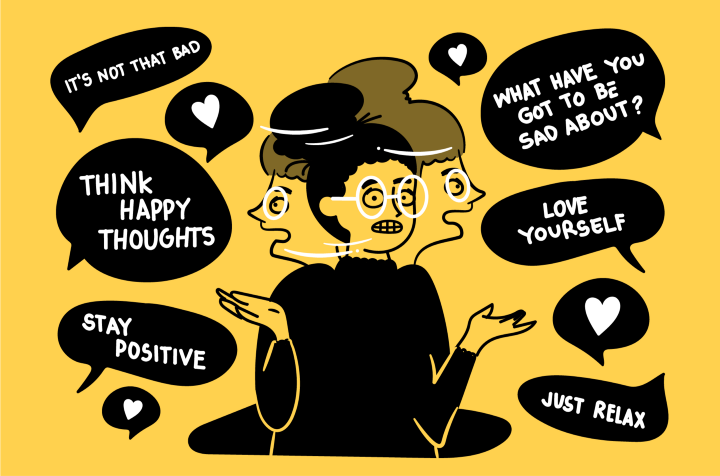Is it time to end the 'positive vibes only' movement?
- Frances Weston

- Aug 10, 2021
- 4 min read
When I think about the word optimism, the first word that often comes to my mind is ‘positivity’. I conjure up an idea of someone who sees the world through rose-tinted glasses and thinks positively 24/7.
I often see Instagram posts filled with images such as “a negative mind will never give a positive life” and #goodvibesonly, leading to this idea that we should be positive 24/7. As a medical student interested in mental health, I started thinking about the impact these posts have, and what being positive really means in relation to ‘good’ mental health.
On the surface, the purpose of these posts is to make people feel better and be more ‘positive’ — and for many they do, which is great! However, I have had many discussions with friends about social media — in fact, I wrote a piece on the effects of social media on adolescents — and how in excess these posts and comments can create a pressure that we should be having a fun, positive time all the time.
In reality, being positive all the time is a completely unrealistic idea. As humans, we’re made to experience the full range of emotions whether it be sadness and stress, or happiness and gratitude. Research has shown repressing our negative emotions has negative effects on both our mental and physical health, highlighting the importance of accepting the full spectrum of our emotions.
The last 18 months have been filled with uncertainty and change due to various COVID-19 restrictions and their repercussions. Throughout, I have personally experienced people responding to these situations with hyper-positive statements and have seen many similarly positive posts on TikTok and Instagram. For example, posts of encouragement to ‘make the best of a bad situation’ or telling someone who’s lost a loved one to ‘try to stay positive’.
These statements could be interpreted as a type of positive reframing, a process where a situation or event that was initially viewed as negative, is viewed through a positive lens, reframing the negative into positive. As recent research studies show, positive reframing has been linked to increased mental wellbeing and fewer depressive episodes, and therefore can be highly beneficial. However, while positive reframing is a hugely valuable technique, if it is misinterpreted or exaggerated, it can turn into what is known as toxic positivity: the exaggerated and overgeneralization of a think positive state no matter the situation.
Just like anything done in excess, if positivity is used excessively or to deny our emotions, it can become ‘toxic’. For example, continuously hearing phrases such as ‘just look at the bright side’ or ‘it could be worse’ can invalidate negative emotions that one may feel. This suppression of negative emotions has been associated with decreased self-esteem and an increased risk of depressive symptoms, thus has negative consequences to short and long term mental health.
Additionally, if positivity is used to dismiss grief or silence negative emotions, people may feel shame about these emotions and pressure to be happy. Shame impacts feelings of acceptance and belonging, and thus can be an isolating experience. Therefore, in times of anxiety, loss or bereavement, being insincere with or invalidating our negative emotions is often counterproductive and can lead to worse mental health outcomes.
Interestingly, a 2018 study looked into the link between emotional acceptance and psychological health. It found emotional acceptance — accepting emotions and thoughts without judging them — was related to a decreased negative emotional response to stressors. Perhaps emotional acceptance should go hand in hand with positive reframing to avoid slipping into this idea of ‘toxic positivity’.
Can we also use optimism to avoid toxic positivity?
I was recently listening to a podcast with Dr Deepika Chopra (known as the Optimism Doctor), a clinical psychologist who did her PhD on the topic of optimism. Interestingly, Dr Chopra does not use the word positivity to define optimism; instead, her 2 keywords are resiliency and curiosity. By this she means:
1. Resiliency: overcoming and persevering through life’s challenges — knowing we have the power to lean into these moments and push through them. Resilience plays a positive role in coping with adversity and thus reduces the risk of anxiety and stress reactions. It has even been shown to predict life satisfaction as we age.
2. Curiosity: being able to be curious about one’s own experience and emotional experience. For example, you might be going through a difficult time, feeling emotions of anger, worry or sadness. However, even when something seems difficult, you can say to yourself: “I am curious how I will grow from this”.
Therefore, for Dr Chopra ‘an optimist is someone who is very aware and mindful of their setbacks or less than ideal situations, however, sees them as temporary, recognizing their ability to overcome them, even if they don’t know exactly how or when’.
She explains that by embracing the challenges and the things that make us feel uncomfortable, we can practice these behaviours and become more optimistic throughout our lives. In this way, we also avoid the toxic positivity mindset.
How do we practice resiliency and optimism?
Recognize all emotions as a normal, valid, and important part of being human
Seek out news that has a positive impact on you, and content you find inspiring — which doesn’t discourage emotional acceptance!
Practice mindfulness, which encourages us to give our emotions ‘space’ to exist. I like to use Headspace, but other popular apps include Calm and Insight Timer
Practice gratitude e.g. through journaling
The bottom line is: optimism and “good” mental health are not about never having negative emotions or going through challenging times. Instead, it’s about remembering it’s OK to feel our emotions, while still looking forward to the possibilities of the future.
Header Image Source: Blackburne House













